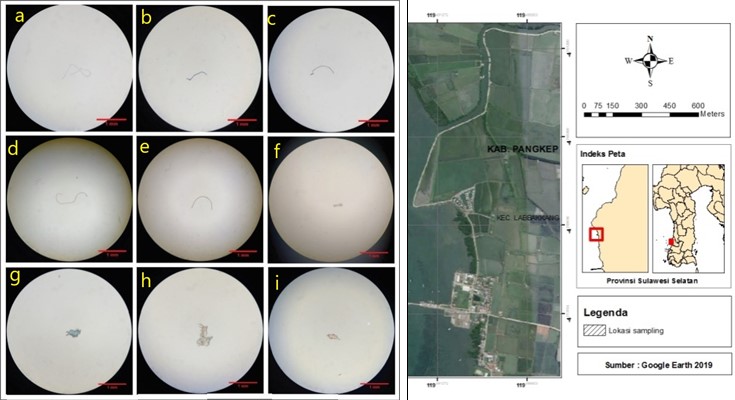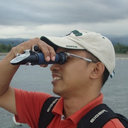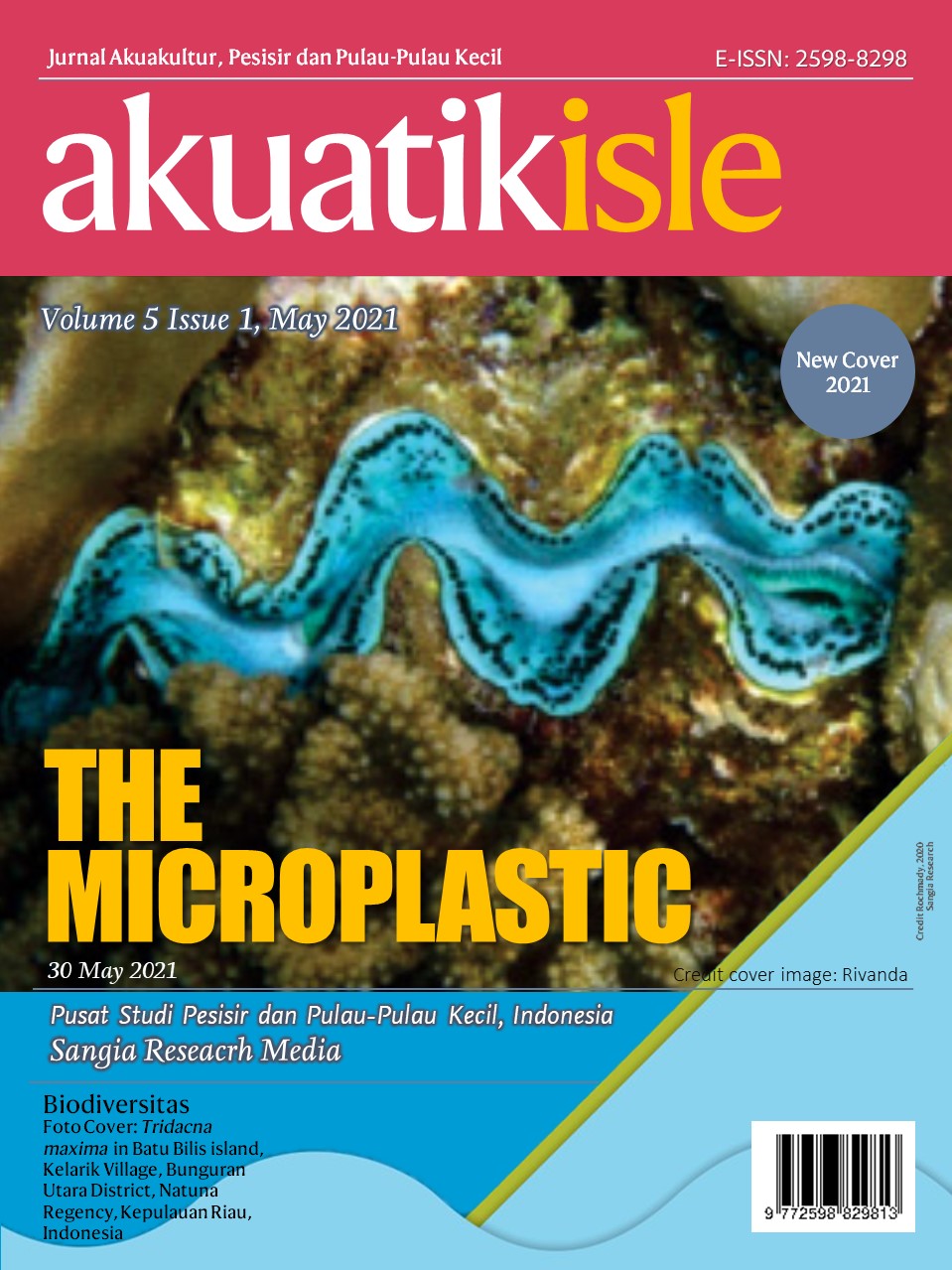Akuatikisle: Jurnal Akuakultur, Pesisir dan Pulau-Pulau Kecil
Full Length Article
Microplastics contamination in green mussels Perna viridis in Pangkajene Kepulauan Waters, South Sulawesi, Indonesia
Highlights
Generate NLP AI by Wizdam ID.
Abstract
Microplastics is a problem that has been concerning, especially in marine habitat. The presence of microplastics in large quantities will have an impact on the environment and marine organisms. Marine organisms that are vulnerable to contamination by microplastics pollutants namely green mussels (Perna viridis). This study aims to determine the microplastics forms and concentration found in green mussels (Perna viridis) in Maccini Baji Waters, Labakkang District, Pangkejene Kepulauan Regency, South Sulawesi. The sampling of the mussels was carried out by the method of purposive random sampling with the sample was grouped into 3 groups of shells lengths, namely 2-3.9 cm, 4-5.9 cm and 6-7.9 cm with 33 individuals for each group. Microplastics observations were carried out using a stereo microscope. In addition to analyze microplastics concentrations, an analysis of the frequency of microplastics presence in shells was also carried out. The results showed that the microplastics was found in the form of fiber and fragments with several colors namely clear white, blue, black, red, and purple. The frequency of microplastics presence in green mussels was above 50% with an average of 71.7% exposure to microplastics. The highest frequency of microplastics presence and concentration in the range of shell lengths accounting for 2-3.9 cm.
Keywords
Introduction
Section snippets
Material and Methods
Materials and methods from the full-text PDF of this article cannot be displayed.
Results
Results from the full-text PDF of this article cannot be displayed.
Discussion
Discussion from the full-text PDF of this article cannot be displayed.
Conclusions
Conclusions from the full-text PDF of this article cannot be displayed.
Acknowledgment
Acknowledgment from the full-text PDF of this article cannot be displayed.
Competing interest
The authors declare that they have no known competing financial interests or personal relationships that could have appeared to influence the work reported in this paper.
Conflict of interest
The authors declare that the research was conducted in the absence of any commercial or financial relationships that could be construed as a potential conflict of interest.
Ethical approval acknowledgements
No ethical approval required for this article. All procedures followed were in accordance with the ethical standards of the responsible committee on human experimentation (institutional and national) and with the Helsinki Declaration of 1975, as revised in 2008 (5)
Data availability
All the data have been provided via Supplementary files. Any further information can be requested from the corresponding author via email upon reasonable request.
Appendix. Supplementary materials
Supplementary File 1: Surat Pernyataan Naskah (Research Instrument)
Declarations information
License and permission
 This work is licensed under a Creative Commons Attribution-ShareAlike 4.0 International License (https://creativecommons.org/licenses/by-sa/4.0), which permits use, sharing, adaptation, distribution and reproduction in any medium or format, as long as you give appropriate credit to the original author(s) and the source, provide a link to the Creative Commons licence, and indicate if changes were made. The images or other third party material in this article are included in the article's Creative Commons licence, unless indicated otherwise in a credit line to the material. If material is not included in the article's Creative Commons licence and your intended use is not permitted by statutory regulation or exceeds the permitted use, you will need to obtain permission directly from the copyright holder.
This work is licensed under a Creative Commons Attribution-ShareAlike 4.0 International License (https://creativecommons.org/licenses/by-sa/4.0), which permits use, sharing, adaptation, distribution and reproduction in any medium or format, as long as you give appropriate credit to the original author(s) and the source, provide a link to the Creative Commons licence, and indicate if changes were made. The images or other third party material in this article are included in the article's Creative Commons licence, unless indicated otherwise in a credit line to the material. If material is not included in the article's Creative Commons licence and your intended use is not permitted by statutory regulation or exceeds the permitted use, you will need to obtain permission directly from the copyright holder.
Publisher's Note
Sangia Publishing remains neutral with regard to jurisdictional claims in published maps and institutional affiliations.
References (14)
Cohen, L.; Manion, L. & Morrison, K., 2007. Research Methods in Education. New York: Routledge.
Dewi, S.; AA, B. & IR., R., 2015. Distribusi mikroplastik pada sedimen di muara badak, Kapupaten Kutai Kartanegara. Universitas Mulawarman.
Katsanevakis, S. & Katsarou, A., 2004. Influences on the distribution of marine debris on the seafloor of shallow coastal areas in Greece (Eastern Mediterranean). Water, Air, and Soil Pollution, (159): 325–337.
Khoironi, A.; Anggoro, S. & Sudarno, S., 2018. The existence of microplastic in Asian green mussels. IOP Conference Series: Earth and Environmental Science, 131(1), 012050, DOI: 10.1088/1755-1315/131/1/012050.
Krebs, C. J., 2014. Ecological Methodology. Addison-Wesley Educational Publishers, Inc.
Ningrum, E. W., 2016. Efektivitas Pepurasi Merkuri pada Kerang Hijau (Perna viridis l.) dan Kerang Darah (Anadara granosa l.) dari Teluk Jakarta dengan Penggunaan Ozon, Kitosan dan Teknik Hidrodinamik. Institut Pertanian Bogor.
Nor, M. & Obbard, J. P., 2014. Microplastics in Singapore’s coastal mangrove ecosystems. Marine Pollution Bulletin, 79: 278–283.
Qu, X.; Su, L.; Li, H.; Liang, M. & Shi, H., 2018. Assessing the relationship between the abundance and properties of microplastics in water and in mussels. Science of the Total Environment, 621: 679–686, DOI: 10.1016/j.scitotenv.2017.11.284.
Rochman, C. M.; Tahir, A.; Williams, S. L.; Baxa, D. V; Lam, R.; Miller, J. T.; Teh, F.; Werorilangi, S. & Teh, S. J., 2015. Anthropogenic debris in seafood : Plastic debris and fibers from textiles in fish and bivalves sold for human consumption. Scientific Reports, 5: 1–10, DOI: 10.1038/srep14340.
Storck, F. R.; Kools, S. A. E. & Rinck-Pfeiffer, S., 2015. Microplastics in Fresh Water Resources. Journal of Science Brief, 72(5): 1455–1457, DOI: 10.1111/j.1741-3737.2010.00777.x.
Tantanasarit, C.; Babel, S.; Englande, A. J. & Meksumpun, S., 2013. Influence of size and density on filtration rate modeling and nutrient uptake by green mussel (Perna viridis). Marine Pollution Bulletin, 68(1): 38–45.
Wright, S. L.; Thompson, R. C. & Galloway, T. S., 2013. The physical impacts of microplastics on marine organisms: A review. Environmental pollution (Barking, Essex : 1987), 178: 483–492, DOI: 10.1016/j.envpol.2013.02.031.
Yaqin, K.; Fachruddin, L. & Rahim, N. F., 2015. Studi Kandungan Logam Timbal (PB) Kerang Hijau, Perna viridis Terhadap Indeks Kondisinya. Jurnal Lingkungan Indonesia, III(6): 309–317.
Yaqin, K.; Nursyamsiah; Umar, M. T.; Fachruddin, L. & Bachtiar, B., 2014. Apakah variasi ukuran panjang cangkang memengaruhi konsentrasi logam timbal di dalam daging kerang hijau, Perna viridis? Prosiding Simposium Nasional I Kelatan dan Perikan. Fakultas Ilmu Kelautandan Perikanan, Universitas Hasanuddin Makasssar, : 1–13.
Bibliographic Information
Cite this article as:
-
Submitted
3 December 2020 -
Revised
1 February 2021 -
Accepted
4 March 2021 -
Published
5 March 2021 -
Version of record
9 April 2021 -
Issue date
30 May 2021
-
Academic subject
Environmental Science; Marine Sciences
Copyright
Sangia Advertisement
At the first time, plastic materials were produced to facilitate various activities of human life. Plastic materials that are flexible and durable pollution both on land and the sea. Plastic materials that are not managed properly can contaminate human and life, either directly or indirectly to food sources, especially food from the sea.
Copyright © 2021 Ramli, Khusnul Yaqin, Nita Rukminasari. Sangia Research Media and Publishing. Production and hosting by Sangia (SRM™).  This work is licensed under a Creative Commons Attribution-ShareAlike 4.0 International License.
This work is licensed under a Creative Commons Attribution-ShareAlike 4.0 International License.
Disclaimer: All claims expressed in this article are solely those of the authors and do not necessarily represent those of their affiliated organizations, or those of the publisher, the editors and the reviewers. Any product that may be evaluated in this article or claim that may be made by its manufacturer is not guaranteed or endorsed by the publisher.
Comments on this article
By submitting a comment you agree to abide by our Terms and Community Guidelines. If you find something abusive or that does not comply with our terms or guidelines please flag it as inappropriate.









